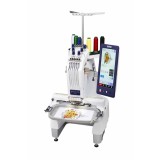
If you’re looking for a high-end machine that will be used for multiple purposes, then cross a multi-needle off the list as embroidering is their full-time job. They make 1-off customized costumes that require one or two small embroidery designs but a lot of customized sewing.

For example, I’ve met successful business owners who focus mainly on the cosplay market. Depending on your target market, it might be important to you that the machine you buy is friendly for embroidery and includes sewing or quilting features. This goes against one of the basic rules as an embroidery business owner: If your machine isn’t running, you’re not making money!Īlthough I usually recommend multi-needle machines, there are some exceptions. This means that you will continually have to stop the machine for designs with multiple color changes so you can pull the next color of thread through the needle. This occurs because the hoop’s side that hooks into the machine frame drives the hoop back and forth, therefore slowing down production time as the motors running aren’t commercial grade.Īnother huge downside is that flatbeds can only run one color at a time.

#Embroidery machines registration#
These machines usually use a hoop rectangular in shape, which can be problematic for registration and quality embroidery. The second you walk away is exactly when the machine would sew into the material hanging over.įlatbed machines also have a decreased speed time. Then your full-time job would be to sit and watch the machine run the entire time.

Instead of something like a towel, where there’s a front & back).Īs an example: if embroidering on a sweatshirt, you’d need to turn it inside out and create a bowl, moving all the excess material out of the way as it embroiders. The embroidery runs on a flat surface, meaning it’ll be challenging to embroider any tubular items (tubular meaning something like a shirt or sock where there’s an inside to it.


 0 kommentar(er)
0 kommentar(er)
